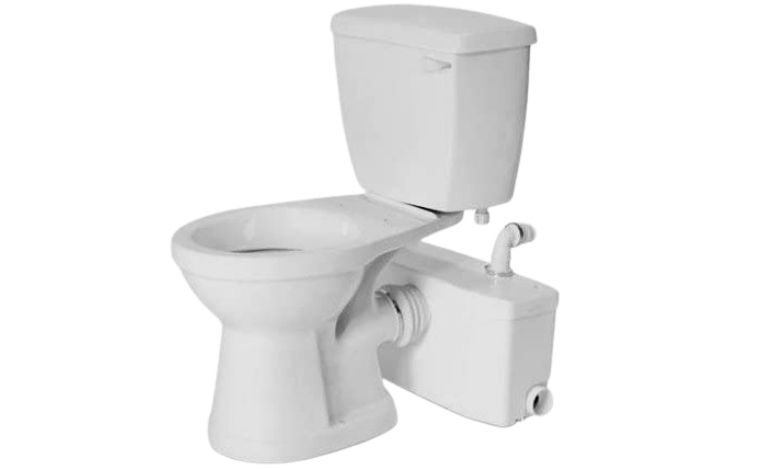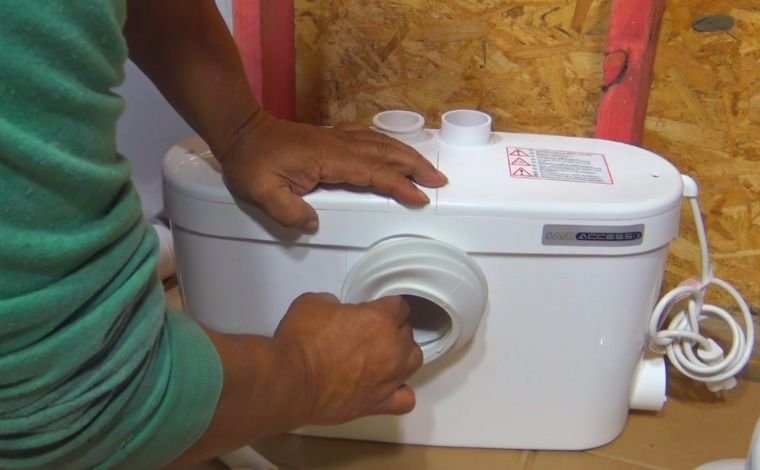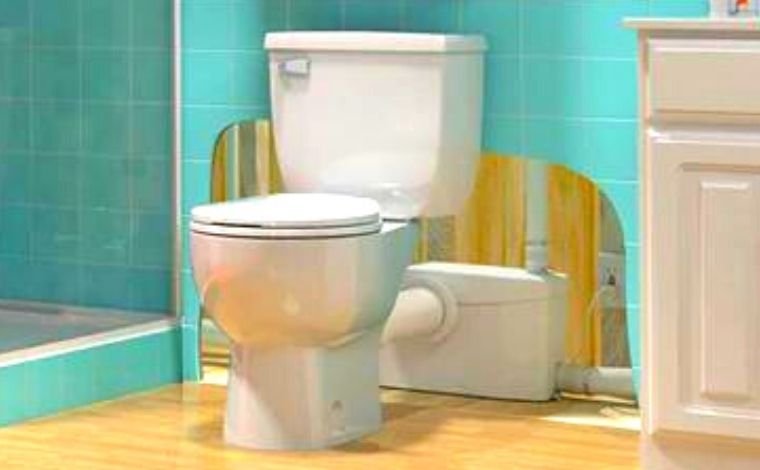Can you imagine how essential a toilet is in our daily life? The average person spends about 45 hours every year sitting on the toilet. That’s why choosing the right one is more than just about looks — it’s about comfort, convenience, and practicality.
If you’re renovating your bathroom or installing a new one in a basement, garage, or attic, an upflush toilet (also called a macerating toilet) could be the ideal solution. It offers flexibility and convenience that traditional toilets simply can’t match. However, like any product, it comes with both advantages and disadvantages. Let’s explore them in detail.
What Is an Upflush Toilet?
An upflush toilet is a modern type of toilet that uses a macerating system to grind waste and pump it upward through a small-diameter pipe to reach the main drain line or septic tank.

In a conventional toilet, gravity moves the waste downward into the plumbing system. But with an upflush system, the waste doesn’t need gravity — instead, it uses a powerful macerator pump that pulverizes waste into a slurry and pushes it horizontally or upward.
This makes it possible to install a toilet below the main sewer line, such as in basements or rooms without existing plumbing.
Unlike standard toilets, you don’t need to dig into the floor or break tiles to install it. The waste exits through a concealed pipe leading to the existing drain, making it ideal for remodeling or adding extra bathrooms.
If you’ve ever heard of brands like Saniflo or Liberty Pumps, those are among the most popular upflush toilet manufacturers.
Advantages of Upflush Toilets
1. Installation Flexibility
One of the biggest reasons homeowners choose an upflush toilet is its installation flexibility.
You can install it almost anywhere — a basement, attic, garage, or even under the stairs — without breaking concrete or building an expensive drainage system. Traditional toilets require direct access to the main sewer line, but upflush toilets give you freedom in placement.
Whether you’re finishing your basement or creating a new guest bathroom, you can set it up in hours instead of weeks.
This flexibility also makes it a favorite among DIY homeowners, small property owners, and renovation enthusiasts.
2. Protects Your Bathroom Walls and Floors
Are you someone who loves the aesthetics of your bathroom? An upflush toilet allows you to maintain the beauty of your walls and tiles because you don’t have to drill or dig through them to install new drainage.
Everything connects neatly through hidden pipelines, keeping your bathroom’s design clean and undamaged. It’s an ideal solution if you want to preserve a modern or luxury finish without visible plumbing work.
3. Easy and Quick Installation
You might think that a modern toilet system would be difficult to install, but surprisingly, it’s not.
Most upflush toilets can be installed in just a few hours with basic plumbing knowledge. There’s no need for expensive contractors or heavy renovation work. You can place the toilet against any wall near an electrical outlet and connect it to your existing drain.
If you choose a model like Saniflo Saniaccess 2, the process becomes even simpler, thanks to its compact macerator pump.
So, if you’re looking for a toilet that saves time, effort, and labor costs — this is a clear winner.
4. Versatile and Sustainable Design
When you remodel your bathroom, traditional toilets often need to be removed or reinstalled, which can be costly.
An upflush toilet, however, adapts to multiple design changes. You can rearrange your sink, shower, or other fixtures without replacing the entire unit.
Its modular design means that even if you change the layout of your bathroom, your upflush system stays compatible.
This makes it an excellent long-term investment for anyone planning frequent renovations or additions.
5. Saves You a Lot of Money
At first glance, an upflush toilet may seem more expensive than a regular one. But when you consider the installation cost, it actually saves you thousands of dollars.
Traditional toilet installations in basements or lower floors require breaking concrete, rerouting plumbing, and professional labor. These can cost $3,000–$6,000 easily.
With an upflush toilet, you can avoid all that. Since no excavation is needed, the total setup cost drops dramatically — often to just $1,000–$1,500 depending on the model.
This money-saving advantage makes it a smart choice for secondary bathrooms, rental properties, or vacation homes.
6. Environmentally Friendly
Water conservation is a growing global concern, and upflush toilets play their part in reducing waste.
Most modern models use only 1.28 gallons per flush (GPF), compared to 1.6 gallons used by standard toilets. Over time, this saves thousands of gallons of water per household.
If you live in an area with water restrictions or care about sustainability, installing an upflush toilet is an eco-friendly decision.
7. Increases Home Resale Value
Adding an extra bathroom can boost your home’s resale value by as much as 20%, according to real estate experts.
With an upflush system, you can easily add a bathroom anywhere — even in areas that previously couldn’t accommodate plumbing.
This feature appeals to homebuyers who appreciate convenience, modern design, and sustainability. A beautifully installed upflush toilet can make your home stand out in the market.
8. Durable and Long-Lasting
You don’t want to buy a new toilet every few years. Thankfully, upflush toilets are built for longevity.
Most macerating units can last 10 to 15 years with proper maintenance. High-quality models from Saniflo, Liberty Pumps, or Zoeller can handle up to 50,000 flushes before requiring any major servicing.
Because the pump and motor are sealed units, they resist corrosion and wear over time. Regular descaling and cleaning ensure that your system remains efficient and odor-free.
9. Portable and Relocatable
Another underrated benefit is portability.
Since the system doesn’t rely on a fixed underground drainage setup, you can relocate it easily when remodeling your house or moving to another property.
For example, if you turn your basement into a guest suite, you can uninstall the unit and reinstall it upstairs — something impossible with conventional toilets.
10. Connects to Other Fixtures
An upflush system doesn’t have to serve only your toilet. It can also connect to a sink, shower, or bathtub, allowing all the wastewater to be pumped through a single line.
This makes it an excellent solution for compact bathrooms or secondary suites where you want to minimize plumbing complexity.
A combined drainage system means fewer leaks, fewer repairs, and a cleaner overall setup.
Disadvantages of Upflush Toilets
Even though upflush toilets have numerous advantages, there are a few drawbacks you should know before buying.
1. Higher Upfront Cost
While installation costs are low, the toilet itself can be more expensive than standard models.
A high-quality upflush toilet can cost between $800 and $1,200, whereas a regular one may cost only $200–$400.
However, this price difference often balances out because of the reduced labor and plumbing costs during installation.
2. Noise During Flushing
Because the system uses a pump and blades to grind waste, it produces a noticeable sound during flushing.
It’s not excessively loud, but compared to a gravity toilet, you’ll definitely hear the motor for a few seconds.
For some people, especially in quiet homes or at night, this sound may feel slightly annoying.
Modern models are much quieter than older ones, but noise-sensitive users should still be aware of this point.
3. Requires Regular Maintenance
Upflush toilets need a bit more care than traditional ones. The macerating unit can accumulate mineral buildup, especially in hard-water areas.
This buildup may cause odors or reduced efficiency over time.
To avoid this, you should descale the system every three to six months using a non-acidic cleaner specifically made for macerating toilets.
Maintenance is easy and quick — you simply pour the descaler into the bowl and flush it through. But skipping maintenance can shorten the lifespan of the motor and blades.
4. Dependence on Electricity
Unlike gravity-fed toilets, upflush systems require electric power to run the pump.
If your home loses power, the toilet won’t function until electricity returns.
This is rarely a major issue, but it’s worth noting for areas prone to frequent outages. Some users keep a backup generator or battery supply for emergencies.
5. Limited Waste Capacity
Upflush toilets are designed mainly for light to moderate use.
If used as the primary toilet in a large household with many users, the macerating system may wear out faster. It’s perfect for guest bathrooms, basements, or secondary use, but for heavy daily use, consider a robust commercial-grade model.
How Long Does an Upflush Toilet Last?
With proper care and regular maintenance, a good-quality upflush toilet can last 10 to 15 years or even longer.
The key components — motor, blades, and pump — are durable, and many manufacturers offer extended warranties of 3–5 years.
If you descale regularly and avoid flushing inappropriate materials (like wipes, pads, or paper towels), your upflush system can perform efficiently for more than a decade.
Common Misconceptions About Upflush Toilets
A common misconception is that upflush toilets are the same as composting toilets, which is not true.
A composting toilet doesn’t use water or a flush mechanism; it relies on natural decomposition to turn waste into fertilizer. An upflush toilet, on the other hand, uses water and mechanical grinding to send waste to a septic tank or sewer system.
They serve entirely different purposes — the former for eco-living and off-grid use, the latter for modern home convenience.
Maintenance Tips to Keep Your Upflush Toilet in Perfect Condition
-
Descale every 3–6 months to prevent mineral buildup.
-
Use only water-soluble toilet paper — avoid wipes or feminine hygiene products.
-
Clean the bowl regularly with mild cleaners; avoid bleach or acid-based solutions.
-
Listen for unusual noises — if the pump runs longer than usual, it might need servicing.
-
Flush the system monthly with warm water and descaler if it’s used infrequently.
Following these steps can extend your toilet’s lifespan and prevent odor or blockage issues.
Final Thoughts
The upflush toilet is one of the most innovative plumbing inventions for modern homes. It provides unmatched flexibility, saves thousands in renovation costs, and makes it possible to add bathrooms almost anywhere.
Yes, it costs more upfront and requires occasional maintenance, but the benefits — from water conservation and easy installation to increased home value — far outweigh the drawbacks.
If you’re remodeling your basement, creating a guest suite, or looking for a cost-effective way to add another bathroom without breaking concrete, an upflush toilet is the smartest solution.
Hi, this is Robert Crossan, the owner of this website, has 17 years of experience in the installation, maintenance, and repair of toilets and plumbing systems. After completing the Level 2 Basic Plumbing course in 2005, I started working in both domestic and commercial buildings as a professional plumber. So I can figure out the core difference between different toilet models and brands. It also helped me monitor their work performance and setbacks.